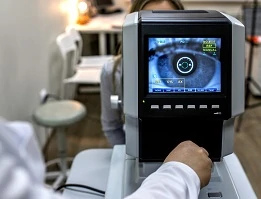Wavefront LASIK: How NASA’s Webb Telescope Advanced LASIK Tech

Imagine being able to see invisible light that is thousands of light-years away. NASA’s newest high-tech telescope – the James Webb Space Telescope – will act as an extension of human vision and allow scientists to view the universe unlike ever before. Advanced scientific missions like the Webb telescope, require cutting-edge solutions.
Who created wavefront technology?
NASA scientists developed wavefront technology to create the telescope’s high-powered optical system to reveal the mysteries of space. Today, that same wavefront technology powers LASIK laser vision correction procedures.
What is wavefront LASIK?
LASIK wavefront in its simplest definition, the technology uses laser light to measure surfaces. How the light bounces off the surface provides data that can be measured to generate a high-definition map in minute, microscopic detail. Today, wavefront data – created from the surface of the patient’s eye – is used to drive laser vision correction. NASA engineers developed and evolved wavefront technology to help craft elements of the Webb telescope optical system.
The telescope uses a primary mirror to capture infrared light, which is sent to the telescope’s scientific instruments for analysis, and then the data is fed down to Earth. The precision of the mirror’s surface and curvature are crucial elements to the success of the telescope. To optimize the Webb telescope mirror surface, NASA deployed wavefront technology, one of many examples of NASA innovation that is used today in everyday life to benefit people everywhere.
How does LASIK wavefront work?
The Webb telescope wavefront technology generates 5 times the amount of data – compared to previous generations of eye-mapping technology – to measure the aberrations and irregularities of a patient’s eye. Today’s wavefront LASIK provides eye surgeons with more accurate and precise measurements to drive the treatment plan to achieve better quality of vision from laser vision correction for each patient.
What does a professional ophthalmologist think about wavefront?
RSC editorial advisor and ophthalmologist Dr. Blake Williamson says, “Bringing proven space technology to medical sciences is a no-brainer if you find areas of synergy where it can better serve patients. A lot of the great advancements and innovations in medical sciences come from the joining of two disparate fields — like NASA and ophthalmology.”
The largest and most complex space telescope ever, the James Webb Space Telescope launched December 25, 2021, on an Ariane 5 rocket from Kourou French Guiana. As the world’s premier space science observatory, Webb will solve mysteries in our solar system and look deeper into the universe. Its mission will last 5-10 years and will complement and extend the discoveries of the Hubble Space Telescope with longer wavelengths and improved sensitivity. Webb is an international project led by NASA with its partners, ESA (European Space Agency) and the Canadian Space Agency. For more information on the Webb telescope and its launch: https://jwst.nasa.gov/content/webbLaunch/index.html
The Refractive Surgery Council (RSC) Editorial Advisory Board is comprised of some of the world’s leading refractive surgeons, thought-leaders, and innovators that review and approve our articles, as well as identify and interpret the latest findings in the field of refractive surgery. The Refractive Surgery Council Verified Seal means that every article we share represents the highest standards in the field of refractive surgery.




